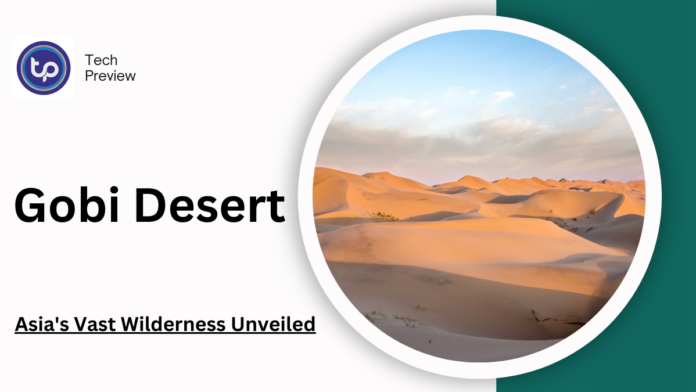The Gobi Desert, known as the largest desert in Asia, is a vast and intriguing landscape that spans northern China and southern Mongolia. With its diverse ecosystems and rich historical significance, the Gobi holds a prominent place in both natural and cultural contexts.
This article delves into the geographical features, climatic extremes, biological diversity, human interactions, and cultural representations of this extraordinary desert.
Geographic Overview of the Gobi Desert
The Gobi Desert stretches about 1,600 kilometres from west to east, with a width that varies between 500 and 1,000 kilometres. Encompassing approximately 1.3 million square kilometres, this immense desert is not merely a uniform expanse but a complex tapestry of varied terrains.
Dimensions and Extent
Occupying around 1.3 million square kilometres, the Gobi surpasses many nations in size, including Peru. Its vastness underscores its significance as a key natural feature on our planet.
MUST READ: Politicser Pepperboy: Exploring Political Satire and How to Make Travel Archives
Cultural and Historical Importance
The Gobi Desert has been crucial throughout history, especially as a segment of the ancient Silk Road. This extensive network of trade routes enabled the exchange of goods, ideas, and cultures between the East and West, with the Gobi acting as both an obstacle and an essential link for traders and travellers.
Weather and Geography
The Gobi is infamous for its extreme weather patterns. Summer temperatures can reach over 40°C, while winter temperatures can drop to a frigid -40°C.
These extreme temperature fluctuations define the desert’s harsh conditions and present significant challenges for its flora and fauna.
Unlike the common perception of deserts filled with endless sand, the Gobi features a diverse landscape. Sand dunes comprise only about 5% of its area, while the rest include rocky plains, gravel flats, and rugged mountain ranges.
Notable landmarks include the expansive Khongor Sand Dunes and the striking Flaming Cliffs.
Plant and Animal Life
Despite the harsh environment, the Gobi supports a surprising variety of plant species. Resilient shrubs, grasses, and unique plants such as the Saxaul tree and Mongolian chives thrive in this arid climate, playing critical roles in soil stabilization and providing habitat for wildlife.
The Gobi is home to an impressive range of animal species, many of which are uniquely adapted to endure its extreme conditions. Iconic species include the Gobi bear, snow leopard, jerboa, and Bactrian camel, all exhibiting fascinating adaptations that enable them to survive in this challenging ecosystem.
Human Influence and Impact
For centuries, nomadic communities, primarily consisting of Mongols and Han Chinese, have lived in the Gobi. Their traditional ways of life revolve around herding livestock, with seasonal migrations being a common practice.
These communities inhabit portable yurts known as Gers, which are well-suited to the desert’s environment.
The Gobi Desert faces considerable challenges from desertification, driven by human activities such as overgrazing and deforestation. Climate change further exacerbates these issues. Initiatives like the Great Green Wall of China aim to combat these threats through extensive tree planting and soil stabilization efforts.
The Gobi in Popular Medi
The Gobi Desert frequently appears in crossword puzzles, including prominent publications like the New York Times. Its distinctive name and geographical significance make it a well-known clue, often referenced as “Asia’s largest desert.”
The Gobi has been featured in literature, films, and documentaries, captivating the imaginations of many. From the explorations of Marco Polo to modern narratives, the desert’s stark beauty and historical importance resonate in various media.
Biodiversity Significance
The biodiversity of the Gobi Desert is one of its most remarkable attributes. Despite its harsh conditions, it supports a wide range of plant and animal species, many of which are endemic. This biodiversity is essential for ecological balance and draws the attention of scientists and conservationists alike.
The Gobi is also a vital area for paleontological discoveries, yielding significant finds such as the first dinosaur eggs. These discoveries provide critical insights into the Earth’s prehistoric past, making the Gobi a key location for ongoing scientific research.
Exploration and Tourism
The Gobi Desert offers a plethora of attractions for travellers, from the stunning Flaming Cliffs to the vast Khongor Sand Dunes. These sites provide unique opportunities for adventure and exploration, appealing to visitors eager to experience the desert’s breathtaking landscapes.
For thrill-seekers, the Gobi provides numerous adventurous activities, including camel treks, wildlife safaris, and off-road jeep excursions. Visitors can engage with the rugged terrain while exploring ancient ruins and observing rare wildlife, ensuring an unforgettable experience.
Conclusion
The Gobi Desert stands as a remarkable testament to nature’s resilience and beauty. Its expansive territory, rich historical context, and diverse ecosystems make it an essential area of interest for both cultural and scientific exploration. As we continue to learn about this extraordinary desert, we see that it remains a vital part of our global heritage, rich in culture and adventure.
People May Ask
What makes the Gobi Desert significant?
The Gobi Desert is known for its extreme climate, varied landscapes, and historical role as part of the Silk Road trade route.
How extensive is the Gobi Desert?
The Gobi spans roughly 1.3 million square kilometers, making it the largest desert in Asia.
What kinds of wildlife can be found in the Gobi Desert?
The Gobi is home to unique species, including the Gobi bear, snow leopard, jerboa, and Bactrian camel, all of which are adapted to survive in extreme conditions.
What environmental challenges does the Gobi face?
Desertification, primarily driven by human activities and climate change, poses significant threats to the Gobi’s ecosystem.
Click here to learn more.









